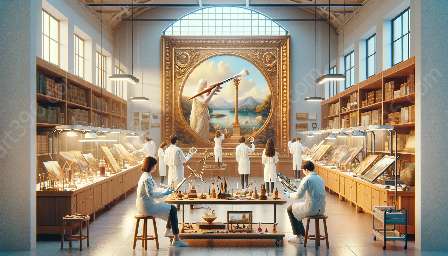Art conservation plays a crucial role in preserving the cultural heritage of a society. One of the key factors that significantly influences art conservation and the ownership of cultural artifacts is the concept of cultural patrimony. This concept not only affects the ways in which cultural artifacts are conserved and curated but also has a profound impact on museums and their role in the preservation of artistic heritage.
The Significance of Cultural Patrimony
Cultural patrimony refers to the cultural heritage or legacy of a nation or region. It encompasses objects, sites, and traditions that are considered to have cultural, historical, or artistic value and are deemed essential for the preservation of a society's identity and collective memory. The concept of cultural patrimony serves as the cornerstone for understanding the significance of art conservation and the ownership of cultural artifacts.
Art Conservation and Cultural Patrimony
Art conservation involves the preservation and restoration of cultural artifacts, including artworks, documents, and historical structures. The practice of art conservation is deeply intertwined with the principles of cultural patrimony, as it aims to safeguard and protect the cultural heritage of a society for future generations. Cultural patrimony influences art conservation by dictating the ethical and legal frameworks within which conservation efforts must operate.
Ethical Considerations
When it comes to art conservation, cultural patrimony raises important ethical considerations. Conservation professionals must weigh the preservation of cultural artifacts against the rights and interests of the communities from which the artifacts originate. This aspect becomes particularly significant in cases where cultural artifacts have been displaced or removed from their places of origin, leading to debates about repatriation and rightful ownership.
Laws and Regulations
Cultural patrimony also intersects with laws and regulations governing the ownership and trade of cultural artifacts. Many nations have enacted legislation to protect their cultural heritage, imposing restrictions on the export, import, and sale of certain artifacts. These legal frameworks are aimed at preventing the illicit trafficking of cultural patrimony and ensuring that cultural artifacts remain within their rightful cultural context.
Museums and Cultural Patrimony
Museums, as custodians of cultural artifacts, are deeply impacted by the concept of cultural patrimony. They are responsible for acquiring, preserving, and exhibiting cultural objects that hold significance to the collective heritage of human societies. Cultural patrimony influences museums in various ways, shaping their acquisition policies, exhibition practices, and approaches to collaboration with source communities.
Acquisition Policies
Within the context of cultural patrimony, museums must carefully consider the provenance and legal status of artifacts before acquiring them for their collections. Due diligence is essential to ensure that the artifacts have not been acquired through illicit means and that their acquisition respects the rights and interests of the communities to which the objects belong.
Exhibition Practices
Cultural patrimony also influences how museums exhibit and interpret cultural artifacts. Museums are increasingly mindful of presenting cultural objects in ways that acknowledge and respect the perspectives of the communities from which the artifacts originated. This approach contributes to a more nuanced understanding of the significance and meaning of cultural artifacts within their cultural contexts.
Collaboration with Source Communities
Recognizing the importance of cultural patrimony, museums are engaging in collaborative efforts with source communities to ensure that the cultural significance of artifacts is preserved and communicated authentically. This collaborative approach involves consulting with communities, indigenous groups, and stakeholders to incorporate diverse perspectives and narratives in the interpretation and presentation of cultural artifacts.
Conclusion
The concept of cultural patrimony exerts a profound influence on art conservation and the ownership of cultural artifacts. It underscores the ethical responsibilities of conservation professionals, informs legal frameworks for artifact protection, and shapes the practices of museums in preserving and presenting cultural heritage. Understanding the impact of cultural patrimony is essential for fostering meaningful and responsible stewardship of the world's artistic and cultural legacy.

